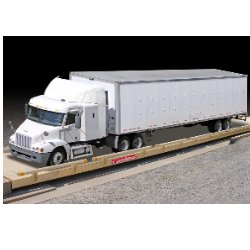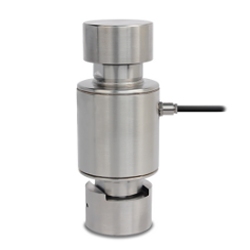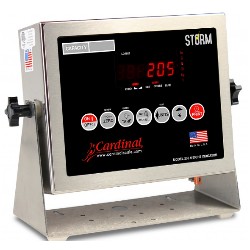You don’t have to look at too many truck scale brochures to become thoroughly confused about what’s available and what is and isn’t important to you. Full-length truck scales may be of either portable or permanent installation. Portable truck scales include a lower framework that is placed on a prepared surface (either a concrete slab, wooden beams, or even dirt) and ramps are placed at either end for access.
Portable scales are generally more expensive because of the lower framework but are much easier to move from site to site and are ideal for contractors or road builders. Scales that are permanently mounted may be mounted either in a pit (like the basement of a home) or of an above-ground low profile design where the scale is mounted on a concrete slab with ramps at either end. The advantages of a pit type scale include easier access to the bottom of the scale, the capability of adding a dump chute in the middle of the scale for unloading of bulk commodities like grain, no requirement for entry and exit ramps and no problems with snow accumulation beneath the platform. Generally, the cost of a pit type scale is greater because of the increased cost of excavation and pit construction. Low profile truck scale designs are less expensive yet require construction of access ramps at either end of the scale.

Both pit type and low profile scales offer a choice in platform material. Platforms may be constructed from concrete or steel plate or, in some cases, wood. The material you choose will depend somewhat on personal preference as well as the way you use your scale. The initial price of a concrete scale will be a little less than an equivalent scale with a steel platform yet when you add in the cost of the concrete and finishing labor, it will exceed the cost of its steel decked cousin.
Concrete Deck or Steel Deck?
Concrete also requires a curing time which will delay the use of the scale but concrete is less slippery in wet weather, is not affected by most chemicals, doesn’t rust, requires little or no maintenance and provides years of service. Steel decks are usually constructed from checkered plate which gives extra traction in wet weather. In general, if your application calls for heavy loads and lots of them, concrete is the preferred material for the scale deck.
Scales are available in either full electronic or electromechanical models as well. Full electronic scales are directly supported by multiple load cells typically numbering 6 to 12 cells or more depending on the length of the scale. Electromechanical scales are supported by a series of bearings attached to ends of levers mechanically summing the forces applied to the scale platform. A summed force is applied to a single load cell. Most truck scales today are of the full electronic type simply because they are easier and less expensive to construct.
Electromechanical scales are still available from some manufacturers and offer some unique advantages. The use of a single load cell makes the scale less susceptible to damage from lightning and they require less power to operate which means a simple battery operated weight indicator can be used when power is not available. Disadvantages of the electromechanical scale include the need for periodic maintenance or repair due to the wear in the bearings of the mechanical lever structure and higher initial cost. The full electronic truck scale has a lower initial price and is easier to work on since there is no complex lever system.

The individual load cell signals of a full electronic truck scale must be summed to provide the total weight signal to the weight indicator. Summing of the load cell signals normally takes place within one or more junction boxes typically located at or near the scale. Because the outputs normally differ from load cell to load cell, it is necessary to make compensating adjustments which may become lengthy depending on the method used.
Finally, when choosing a truck scale, consideration should be given to the method of weighbridge restraint used. The weighbridge or scale platform must be constrained so that it does not slide off the supporting structure as a truck enters of leaves the scale. Although there are a number of ways of accomplishing this, the two most common are check rods and bumper bolts.
Bumper bolt systems consist of an adjustable rod or bolt or similar device attached to the weighbridge and positioned such that it strikes the adjacent foundation or lower structure preventing further movement of the scale weighbridge. This is an effective and simple means of restraining the weighbridge but, to work properly, it must be periodically adjusted to maintain the proper clearance between the adjacent lower structure or scale foundation and bolt head. As the scale is used, this gap changes and must be adjusted to keep the restraint system operating properly.
The check rod type of restraint system is a long thin rod that attaches the weighbridge to the surrounding structure preventing lateral movement of the weighbridge. The ratio between the length of the rod and its diameter is quite large allowing the rod to flex without affecting the accuracy of the scale. Unlike bumper bolts, check rods do not wear and therefore require little or no maintenance.
Truck scales are available in a wide range of sizes. Platform widths from 8 feet up are available while lengths often exceed 100 feet. You should select a platform size that is not only sufficient to weigh the trucks you currently have but large enough to weigh the trucks you may use in the future. Generally, widths of 11 to 12 feet are preferred for trucks used on the highway.
Not only are scales of this width easier to ship, but they are approximately the lane width of many of our nation’s highways. Scales of greater width are available but are more expensive both in initial cost and in the costs associated with testing. Choose a length that is long enough to weigh the largest truck you anticipate weighing in the future. Remember, adding an extra 5 feet or so to the length seven years from now will be much more expensive than purchasing that extra length initially.
Also, keep in mind that the scale must fit within the area you have allocated for the scale remembering to allow for a straight approach and departure from the scale preferably equal in length to the scale platform itself. It’s better to be a little large than too small.

Like platform size, weighing capacity should be selected based on your current and anticipated needs. There are two capacities associated with truck scales. The first, nominal capacity, is the total measurable load that can be distributed over the scale platform. Most truck scales have nominal capacities of 200,000 pounds which is more than sufficient to weigh highway trucks. Selection of the nominal capacity is normally not of concern since it is typically great enough to handle all but the most extreme loads.
As you can see, a lot of thought must take place when considering the purchase of a truck scale. If you are considering or looking for a used truck scale, you need to consider all the topics that were mentioned earlier. You also need to consider the fact that in most cases with a used truck scale, you are buying a scale with very little if any warranty and you are buying a scale that has had thousands and thousands of pounds of equipment driven over it for years. There is also the outdoor element factor that must be considered. What other FAQ about buying truck scales are there?
Finally, many times a specific concrete foundation must be poured to fit the used scale (sometimes you can use an existing foundation) All of these factors must be considered and factored into your total cost of ownership.
